

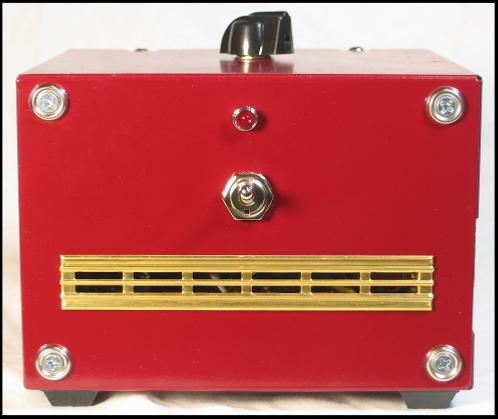
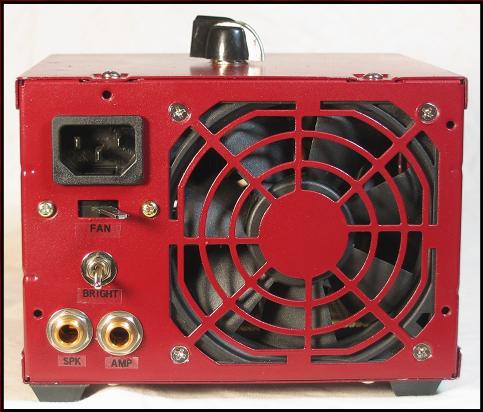
I finally bought a Vox AC30CC, an amp I've wanted for years, and yeah, I know it has a master volume. I like the sound of overdriven power tubes though, so I built this attenuator to get it without cracking the walls. My other DIY attenuators are all 4/8 ohms impedance and the Wharfdales in this AC30cc are 16 ohms wired in series, so I had to build one specifically for it. I made this one unique looking like all my other DIY guitar amp attenuators. I am a big Brian May fan and that is the direction I took when deciding on cosmetics.
Vox did a limited run of special AC30's called the AC30BM. It has only an input jack, a volume control, and power and standby switches. I built the attenuator to resemble it: On the front it has just a bypass switch and an LED indicator light for the fan power supply. The attenuation knob is on the top, the in/out jacks, power switch for the fan, and bright switch are all in the back. The gold grill is a vintage AC30 vent plate I bought online. I painted the enclosure red to match the panel of the AC30BM, and Brian May's Red Special Guitar.
The enclosure is an old computer power supply case similar the one I used for my Coppertone attenuator. The front had holes and open spaces that did not fit my needs, so I cut a piece of aluminum to fabricate a new front panel and drilled new holes. I had to drill and cut out the steel underneath the aluminum to get the switch, LED and vent to mount correctly. It turned out pretty good, I wonder what Brian May would think? Of course, he runs numerous AC30's flat out when playing live, not likely he would want an attenuator!
The circuit is identical to the one I used in my first DIY attenuator, the Ampwell House, except that it is 16 instead of 8 ohms impedance. I removed the back cover of the L-Pad to allow for better heat dissipation. It's just a matter of bending the tabs and removing it. This the only one of my DIY attenuators that doesn't use a wall wart to power the fan. The computer power supply enclosure came with a 12 volt fan and there were screw flanges available to mount a circuit board and a transformer, so I built a 12 volt DC power supply and installed it. (A link to my 9 volt supply is below, just use an LM7812 regulator instead of the LM7809) I used the old IEC power cord connector that was part of the case for the AC feed. I found a switch in my junk box that fit the hole for the old voltage slide switch for the computer power supply, and added it to be able to power the fan on and off. The LED on the front of the case indicates whether the fan is running or not. Didn't really need it because I run the fan all the time when the attenuator is in use but I wanted some kind of indicator light there, so what the hell. Note that this attenuator can be mounted in any kind of enclosure you like, just make provisions for the fan. Also it can be 4, 8, or 16 ohms for whatever amp you have, just buy the correct L-Pad for whichever impedance you require. Don't use this attenuator with amps over about 35 watts rms, the AC30 is close to the top end of its power limits. Still, it quite safe to use with an AC30CC, especially when running it in 22 watt mode. A link to the attenuator schematic/diagram is below.
Vox did a limited run of special AC30's called the AC30BM. It has only an input jack, a volume control, and power and standby switches. I built the attenuator to resemble it: On the front it has just a bypass switch and an LED indicator light for the fan power supply. The attenuation knob is on the top, the in/out jacks, power switch for the fan, and bright switch are all in the back. The gold grill is a vintage AC30 vent plate I bought online. I painted the enclosure red to match the panel of the AC30BM, and Brian May's Red Special Guitar.
The enclosure is an old computer power supply case similar the one I used for my Coppertone attenuator. The front had holes and open spaces that did not fit my needs, so I cut a piece of aluminum to fabricate a new front panel and drilled new holes. I had to drill and cut out the steel underneath the aluminum to get the switch, LED and vent to mount correctly. It turned out pretty good, I wonder what Brian May would think? Of course, he runs numerous AC30's flat out when playing live, not likely he would want an attenuator!
The circuit is identical to the one I used in my first DIY attenuator, the Ampwell House, except that it is 16 instead of 8 ohms impedance. I removed the back cover of the L-Pad to allow for better heat dissipation. It's just a matter of bending the tabs and removing it. This the only one of my DIY attenuators that doesn't use a wall wart to power the fan. The computer power supply enclosure came with a 12 volt fan and there were screw flanges available to mount a circuit board and a transformer, so I built a 12 volt DC power supply and installed it. (A link to my 9 volt supply is below, just use an LM7812 regulator instead of the LM7809) I used the old IEC power cord connector that was part of the case for the AC feed. I found a switch in my junk box that fit the hole for the old voltage slide switch for the computer power supply, and added it to be able to power the fan on and off. The LED on the front of the case indicates whether the fan is running or not. Didn't really need it because I run the fan all the time when the attenuator is in use but I wanted some kind of indicator light there, so what the hell. Note that this attenuator can be mounted in any kind of enclosure you like, just make provisions for the fan. Also it can be 4, 8, or 16 ohms for whatever amp you have, just buy the correct L-Pad for whichever impedance you require. Don't use this attenuator with amps over about 35 watts rms, the AC30 is close to the top end of its power limits. Still, it quite safe to use with an AC30CC, especially when running it in 22 watt mode. A link to the attenuator schematic/diagram is below.
Note, if you build this for your AC30cc, you must use a fan!
Over all I am quite happy with it, it looks cool and sounds great with my AC30CC. There is definitely a difference between using the attenuator and using the master volume, the tone with the attenuator is creamier and thicker, and with the master volume it has a bit more low end, and maybe a little more bite. It can get pretty warm when dialed down with the attenuator but I always keep the fan running to keep it cool. Of course, I'm pushing the power tubes more but that doesn't bother me, and it doesn't seem to bother the amp either. See below for more pictures of my Bohemian Rhapsodyne guitar amp attenuator:
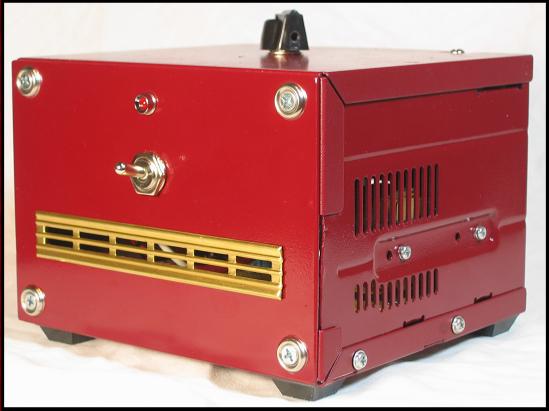
Here you can see the vent I installed, and the vents on the side of the enclosure that were already in place.
The bypass switch is true bypass, and takes the attenuator completely out of the circuit. The LED is lit to indicate when the fan is running.
The bypass switch is true bypass, and takes the attenuator completely out of the circuit. The LED is lit to indicate when the fan is running.
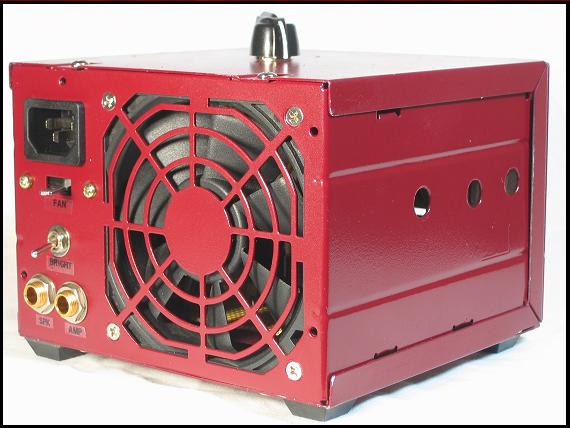
There were no vents on the other side so I drilled a few holes to ensure good air flow when the fan is blowing.
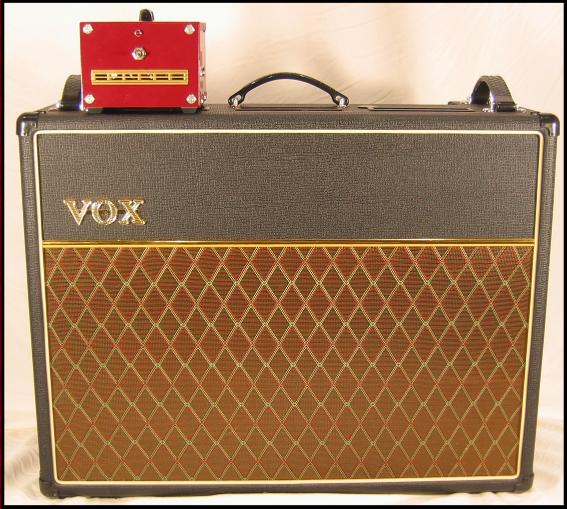
And here it is with my AC30CC.
Links:
Here is the schematic for this attenuator project
Here is the schematic for the power supply for the fan
Parts Express, source for L-Pads and other parts used in this project
The Ampwell House, a guitar amp attenuator built in a coffee can!
My Havanatone Attenuator, a 4/8 ohm attenuator built in a cigar box!
My Ampoline Attenuator, a fixed L-Pad attenuator built in a gas can!
The Coppertone, a 4/8 ohm attenuator built in a computer power supply case!
The Altone, a curiously small guitar amp attenuator, built in an Altoids tin!